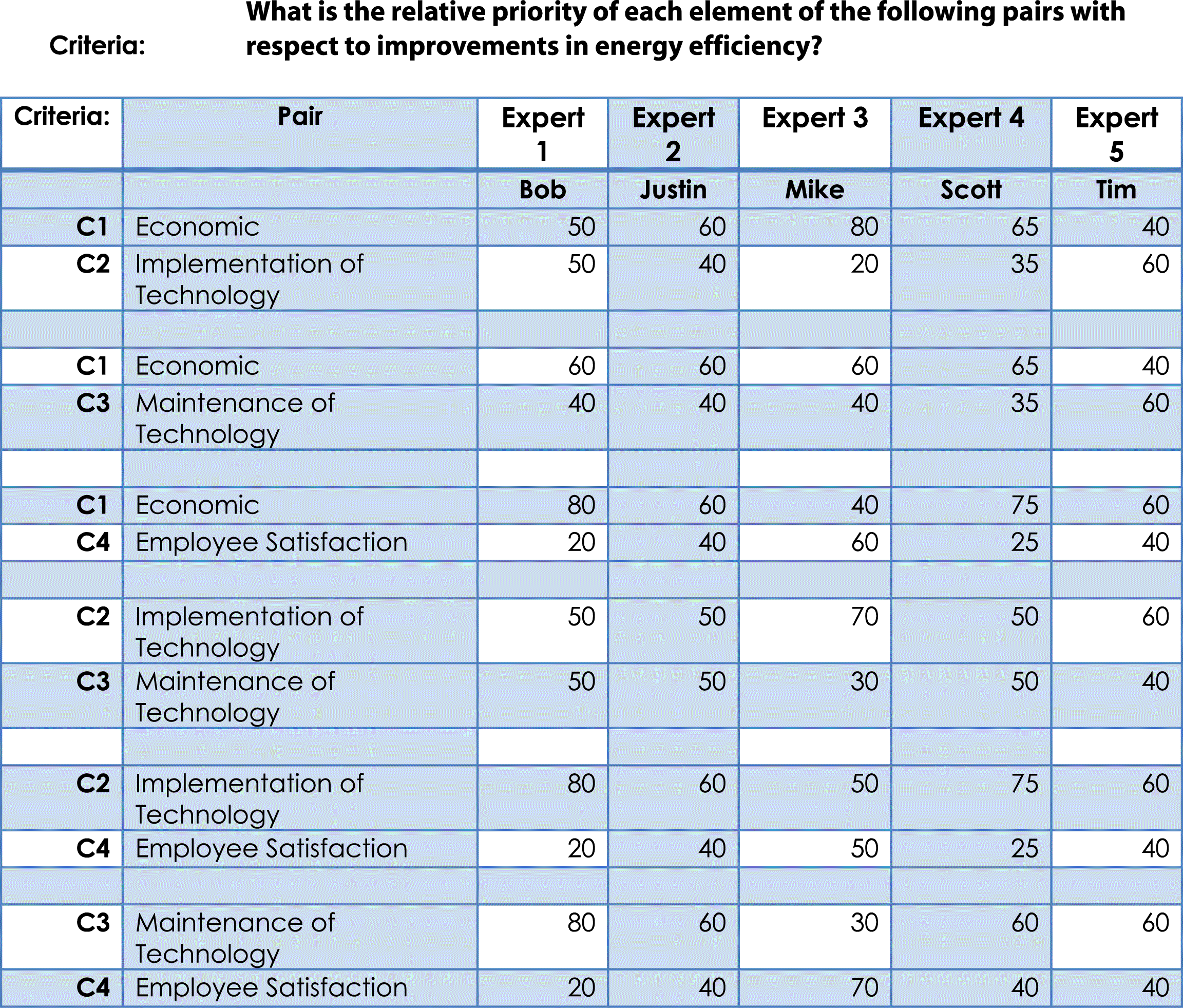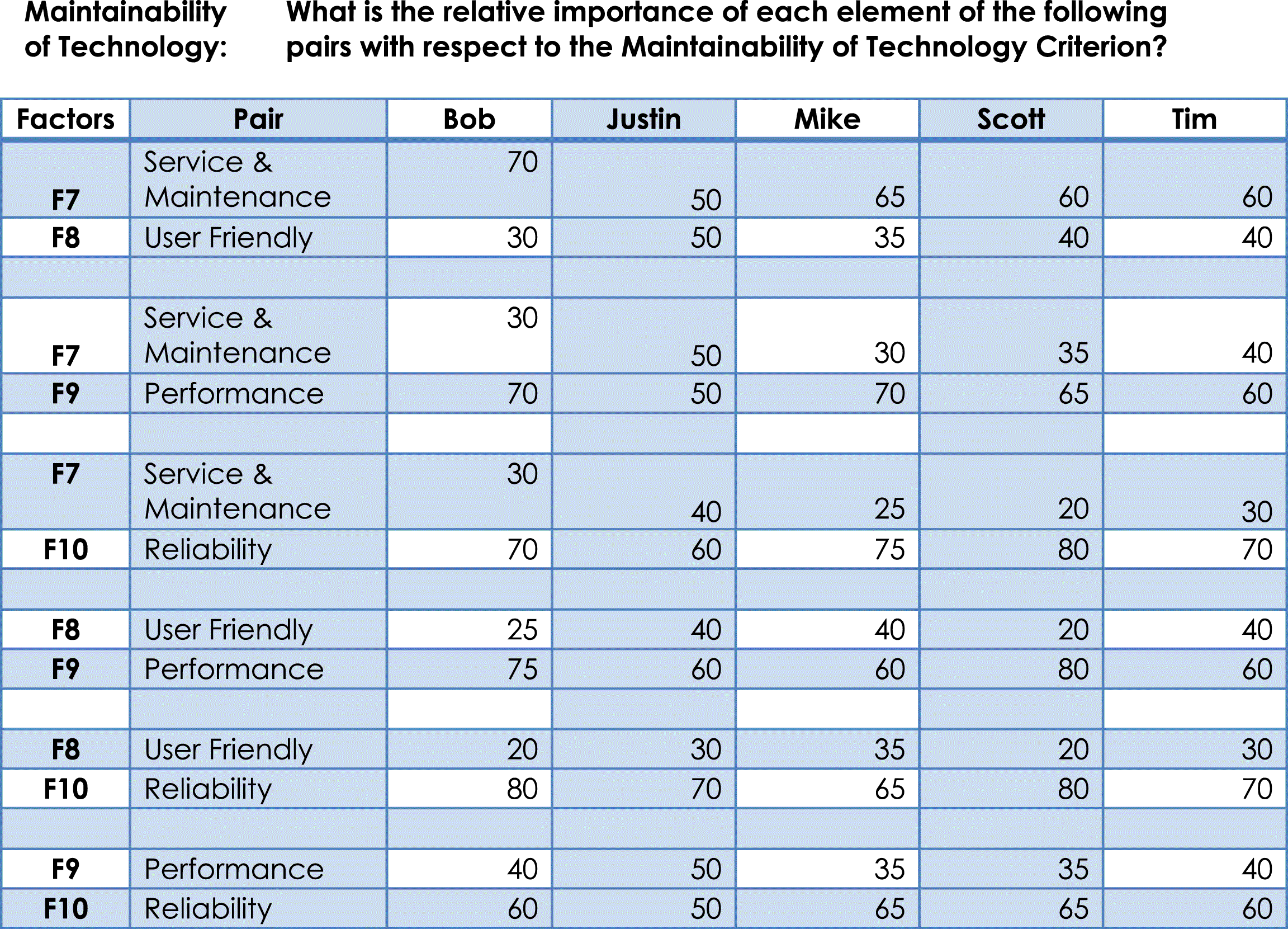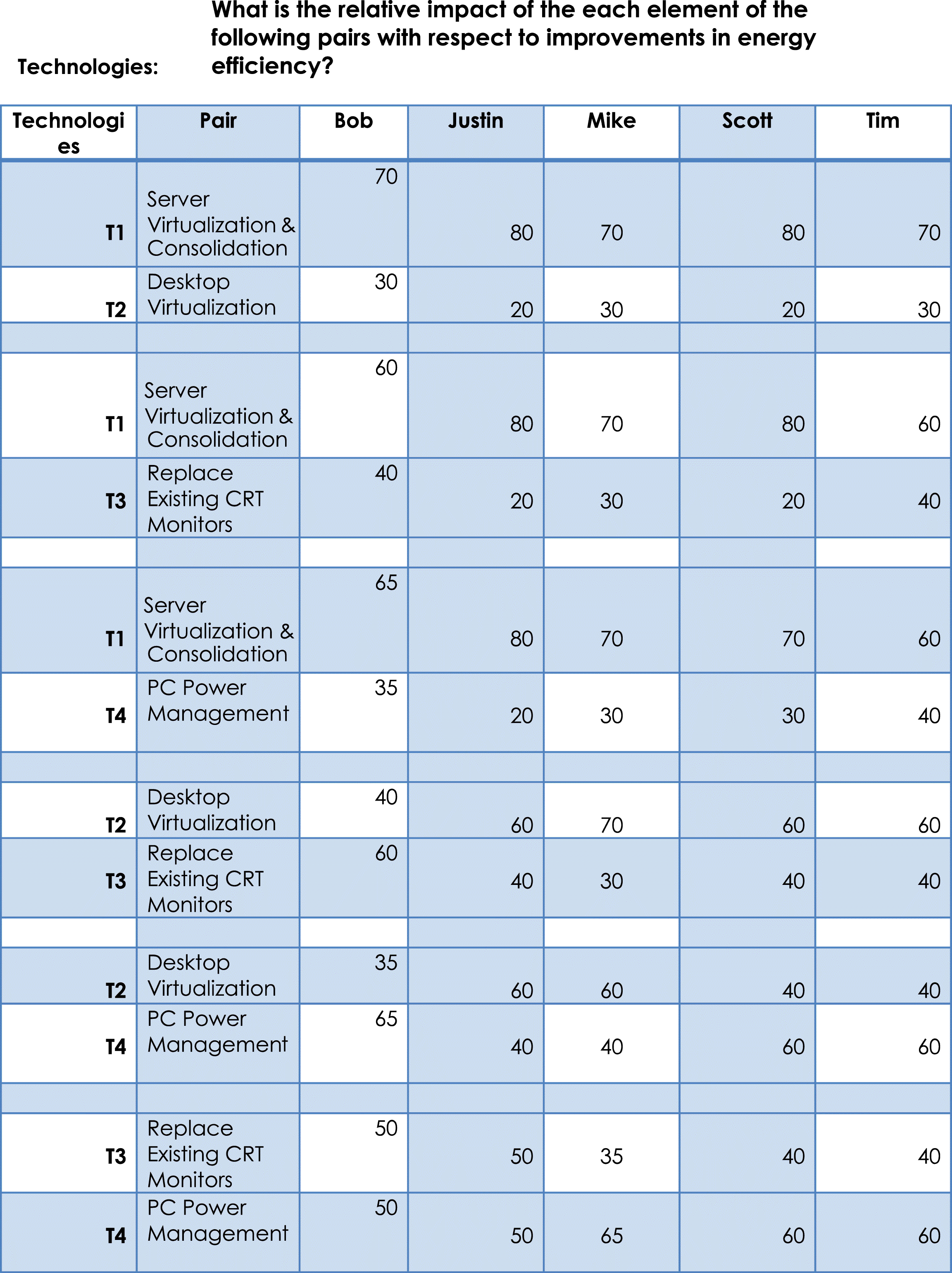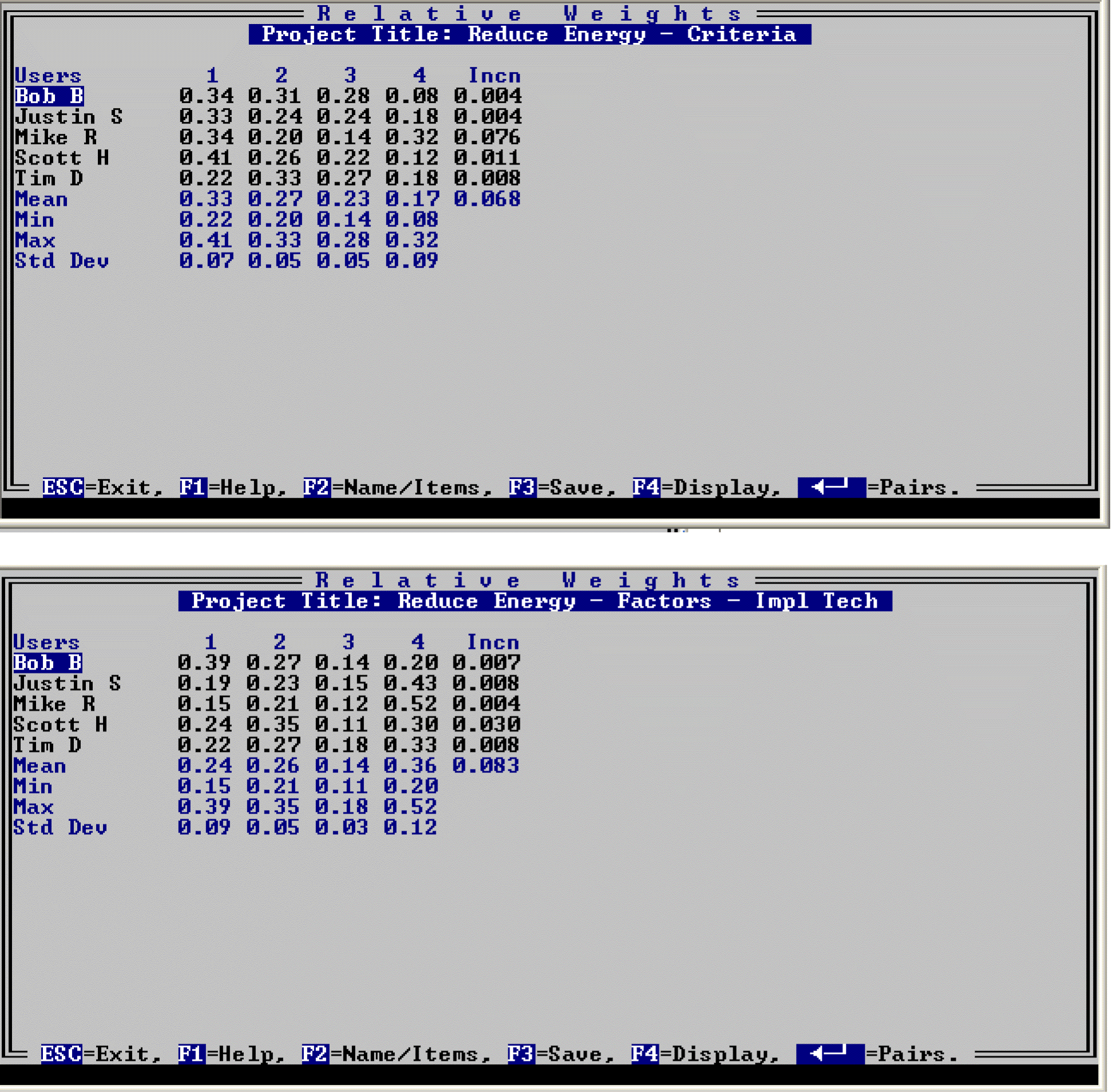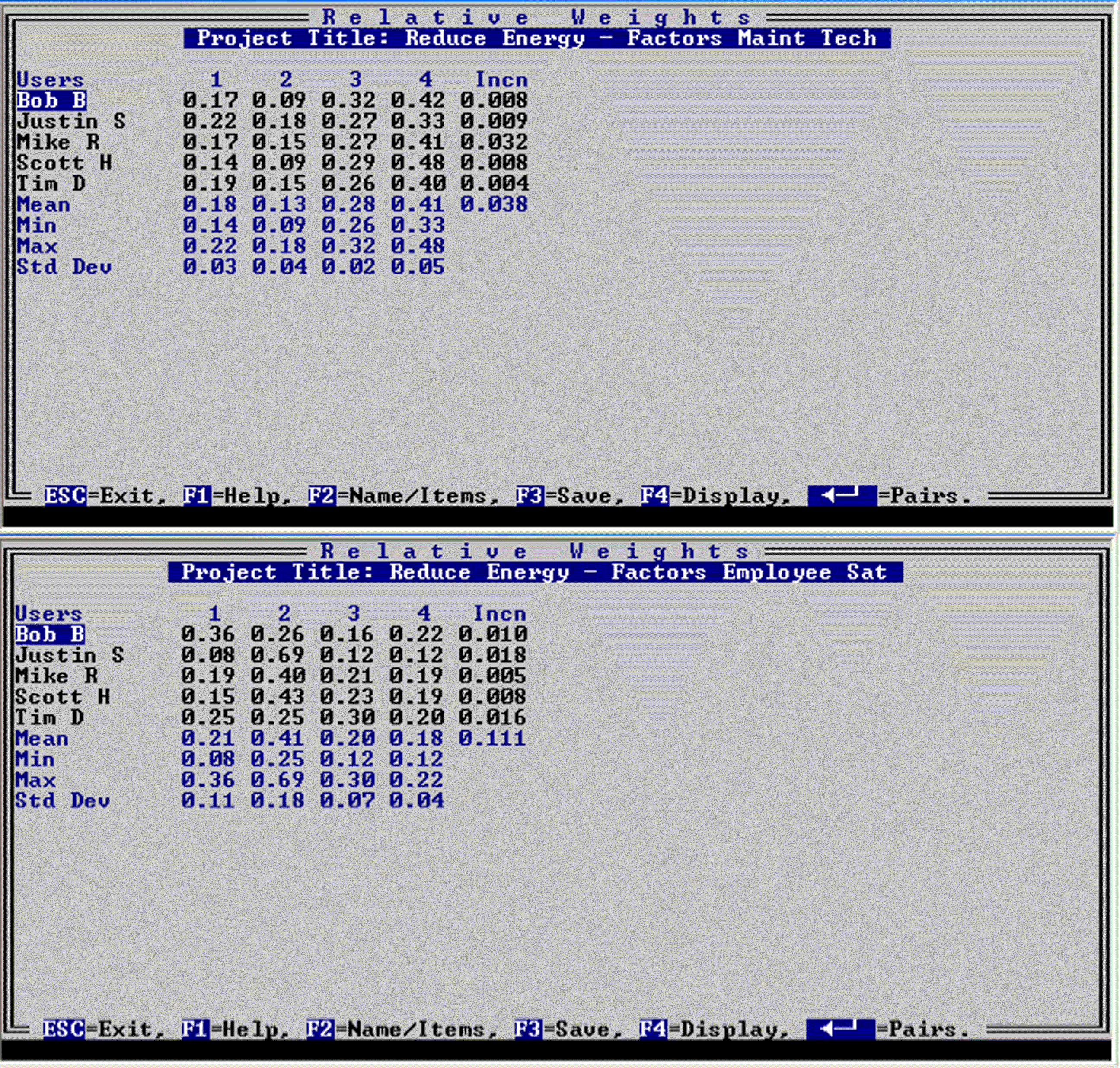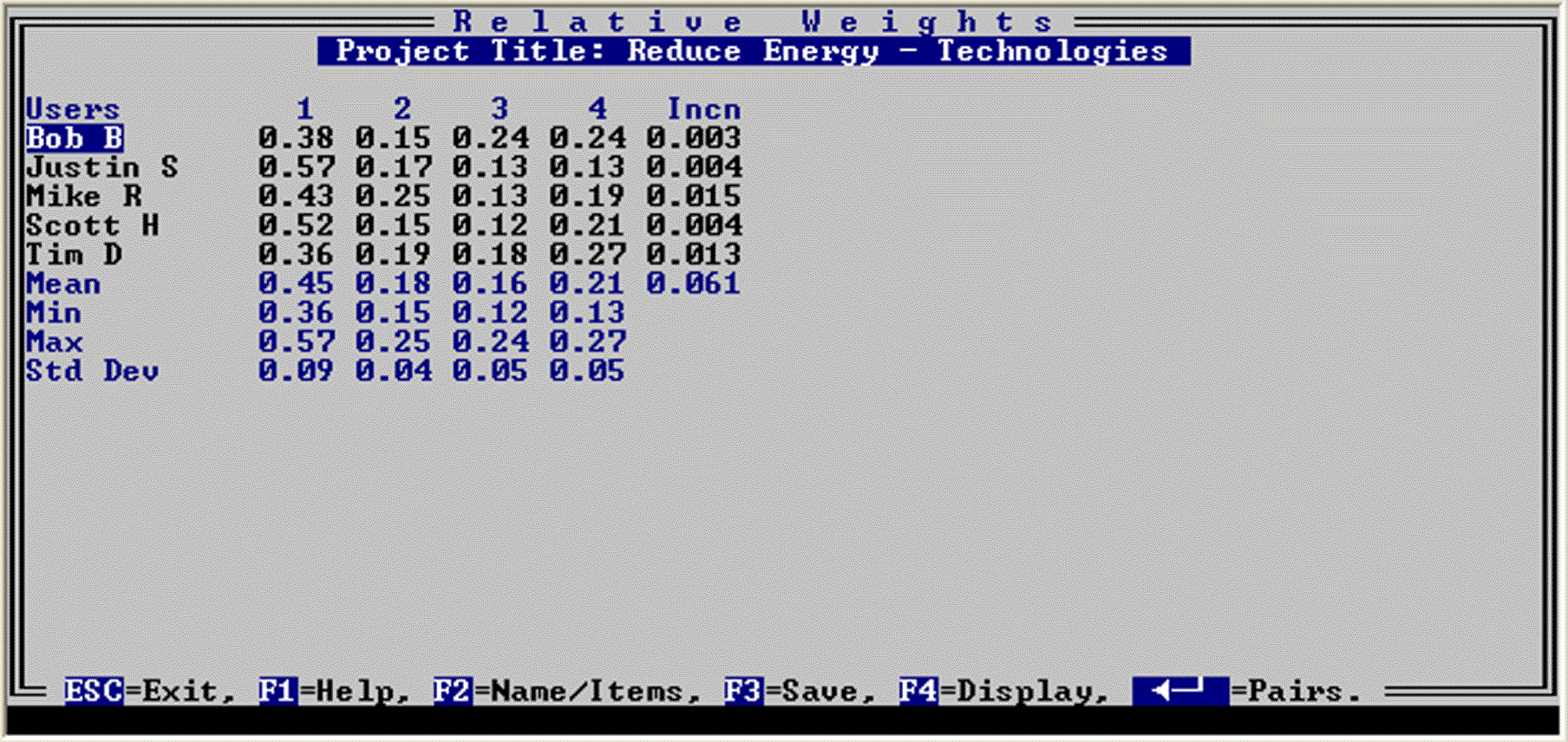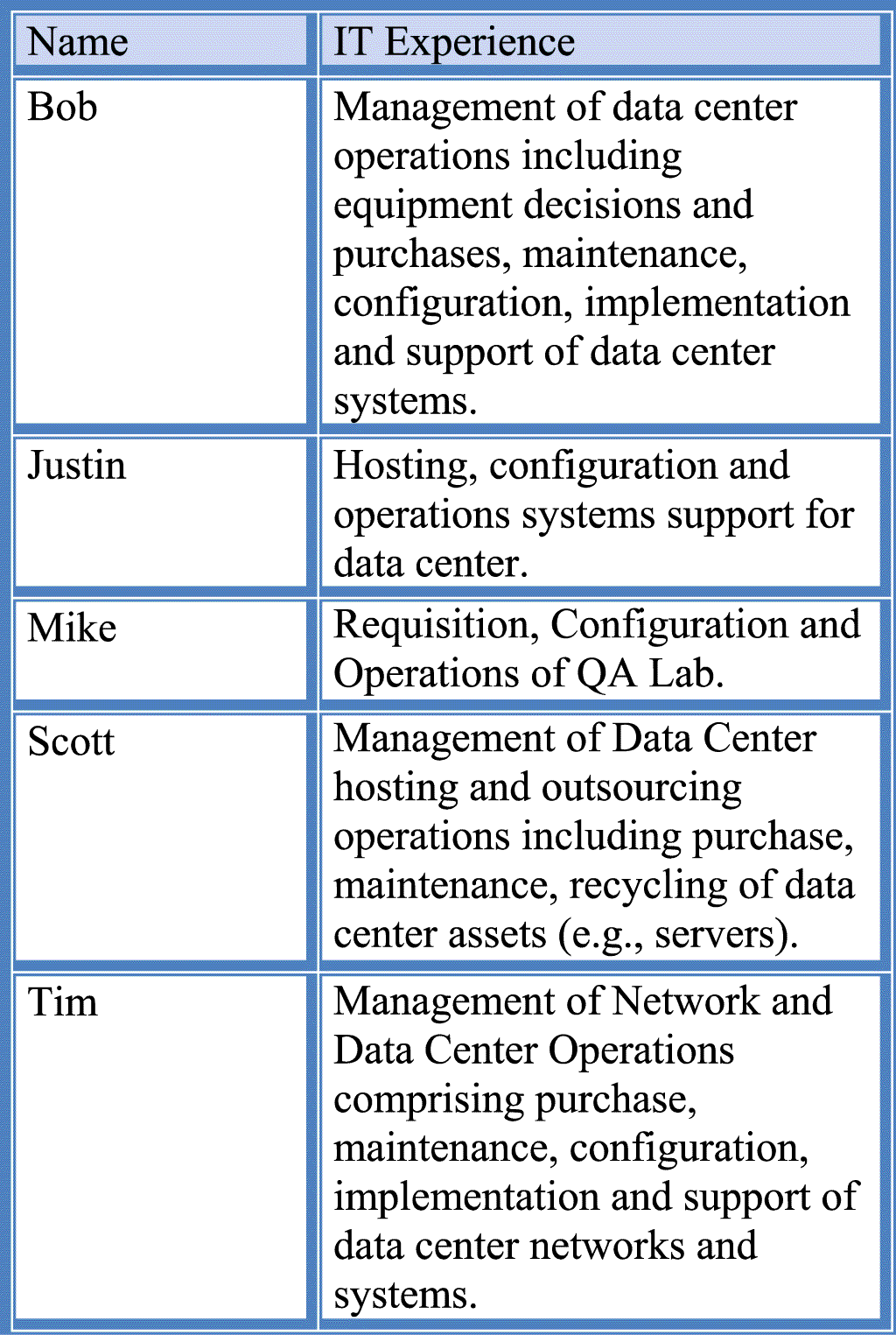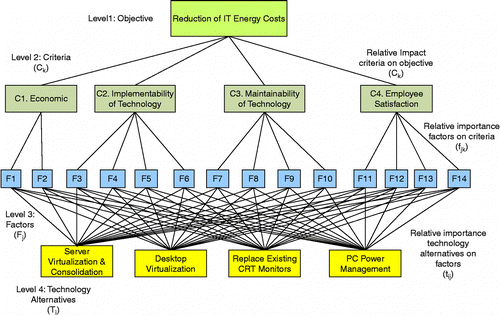Abstract
This study focuses on the technology purchasing decisions of a mid-sized firm (500 employees) that increase the energy efficiency of its computing systems while meeting its business objectives. For example, if company growth requires implementation of a more robust and up-to-date customer tracking system and includes hiring 10 new employees, what course should be followed to ensure a reduction in energy consumption as well as the achievement of company business goals? Should the company purchase a couple of additional servers with limited capacity for growth or should the company replace 20 aging rack servers with six state-of-the-art servers for consolidation and the hosting of virtual machines? And should the company supply the new employees with new cathode ray tube (CRT) monitors or recycle some that have been in storage? There are several alternatives that the firm can use to achieve its goals. This paper evaluates four energy efficiency technologies with respect to their impact on the reduction in energy consumption as well as internal organisational processes and human aspects. A proposed research effort is expected to contribute to energy efficiency literature by capturing adoption decisions from a market – end-user – perspective, and the outcome of this study is proposed to give insights to energy efficiency programme managers into designing more accurate energy efficiency programmes.
1. Introduction
Most businesses today rely on information technology (IT) systems in order to not only enhance their productivity of business processes but to also increase their successes relative to the company strategies. Due to decreasing costs of hardware and software, companies are increasingly implementing new systems to solve business problems in a cost-effective fashion. This has led to the proliferation of hardware systems within many companies. Perhaps those most affected are the mid-range companies, like the one in this study, that require sophisticated systems but sometimes lack sufficient IT staff and budget to meet the strategic ambitions of the company. In this context, power consumption has become a consideration that must be included in IT decisions. For example, IEEE Spectrum projects that within 5 years (i.e. by 2015), the cost of power for data centres will surpass the cost of the equipment (Katz Citation2009).
A market study conducted by McKinsey and Company (Citation2009) showed that the USA has potential annual energy efficiency savings of $130 billion; however, saving opportunities stay unrealised due to barriers associated with the adoption of energy efficient technologies. The same study has also indicated that successful diffusion of energy efficiency measure portfolio could reduce annual energy consumption by 23% by 2020 in the USA. Although significance of energy efficiency savings is clear with respect to its role in environmental- and energy-related issues, a one-size-fits-all methodology cannot be developed due to end-user heterogeneity, technology and utility energy efficiency programme-related variables. In simple terms, energy efficiency measure savings have scattered over a wide range of end-user types and potentially adoptable technologies, which require demand side management (DSM) programmes to strategise investment decisions among various options.
Bounded rationality (Kounetas and Tsekouras 2008, Schleich and Gruber 2008, Sanstad and Howart 1994, Sandberg and Soderstrom 2003) conflicting priorities (Thollander and Ottosson 2008, Thollander et al. 2007, Decanio 1994), the existence of more important projects (Harris et al. 2000, de Groot et al. 2001, Decanic 1994, Thollander and Ottosson 2008, Thollander et al. 2007, Zilahy 2004) and low cost energy consumption relative to business costs (de Groot et al. 2001) have often been claimed as barriers to the adoption of energy efficient technologies.
Energy efficiency gap – a commonly used term in energy efficiency literature – refers to slow adoption of cost-effective energy efficient technologies (Shama Citation1983) and related to that, market barriers are defined as factors causing this particular situation to occur (Jaffe and Stavins Citation1994). A market failure is defined as a special case of a market barrier whose existence in the market might justify for government intervention due to the existence of market violations whereas non-market failures have the same characteristics as market failures in terms of their inhibiting role in adoption, but with a slight difference which is that they may also occur as a result of normally functioning markets (Koomey Citation1990, Sutherland Citation1996, Sorrell et al. Citation2000). For instance, it becomes important to know what conditions make a market functioning optimally in case of justifying policy interventions to the markets. Accordingly, market failures are categorised as incomplete market, imperfect information, imperfect competition and asymmetric information (Sorrell et al. Citation2000). The common point of all the aforementioned information-related issues is that they prevent end-users from accurately assessing the product alternatives in the market. At this point, it should be emphasised that the impact of information on adoption decisions has been widely studied in the energy efficiency literature (Ramesohl et al. Citation1997, Simon Citation1997, de Almeida Citation1998, Harris et al. Citation2000, Sandberg and Soderstrom Citation2003, Thollander et al. Citation2009). Reviewing these studies shows that the literature focusing on the energy efficiency programme adoption does not consider the value of these programmes for the end users. We believe that more decision-maker centric decisions models have a lot to offer insights about slow diffusion of energy efficient technologies. Similar to a study conducted by Daim and Iskin (Citation2010) in case of DSM devices, this study attempts to grasp adoption decisions of energy efficient technology from end-user perspective in the case of IT technologies.
2. Methodology
2.1 Analytic hierarchy process
Analytic hierarchy process (AHP) is a multi-criteria decision analysis method that allows decision-makers to model problems with respect to their understanding of the environment and impacting factors. Due to its flexible nature in model development and ability to enable utilisation of both qualitative and quantitative data, AHP provides decision-making capability even in the complex and uncertain environments where data availability might often be an issue (Meziani and Rezvani Citation1988, Alidi Citation1996, Bhushan and Rai Citation2004). In order to overcome data unavailability expert judgement quantification methods, such as Delphi, pair-wise comparison and utility functions methods, have been widely used in the literature. Although these methods are usually used combined with each other they offer different capabilities. For instance, pair-wise comparison method is utilised for quantifying expert judgements; the Delphi method is used to enable group decision-making whereas use of utility functions creates smarter decision-making models by enabling incorporation of different levels of desirability associated with a given decision criterion. Accordingly, due to its wide range of capabilities and flexible use AHP has been utilised in various different industrial applications for assessment, decision-making, decision sensitivity analysis, forecasting, resource allocation and optimisation problems. In order to summarise specific uses of AHP, studies selected from the literature should be explanatory. For instance, Bertolini et al. (2006) have utilised AHP for portfolio planning in the public sector, Sambasivan and Fei (Citation2008) have prioritised success factors associated with the implementation of ISO 14001 quality systems in electric and electronics industry and Lee and Kozar (Citation2006) have attempted to identify the relationship between financial performance and website popularity. Apart from assessment and selection purposes, AHP has been utilised for forecasting purpose by Das and Chattopadhyay (Citation2003) who have predicted state of a cutting tool by incorporating a number of technical parameters. AHP has also been utilised combined with other operations research methods. For instance, Saaty et al. (Citation2007) have utilised relative weights obtained from AHP model to feed a linear programming model for optimisation of human resource allocation and synergy-related hiring and training decisions. Similarly, Gerdsri and Kocaoglu (Citation2007) have utilised combination of AHP and technology development envelope in an attempt to create more dynamic road-mapping approach.
2.2 Model development
The model development for selecting the technology for reducing IT energy costs involved three steps: technology characterisation, hierarchical decision model and technology evaluation (Kocaoglu Citation1983, Kawamoto et al. Citation2002, Baez and Kocaoglu Citation2006). The technology evaluation model and each component in the hierarchy are based on the research findings (CitationIBM n.d., APPAASBDC Citation2003, Taha et al. Citation2007). The decision model for this study is based on decision models that have previously been studied in the literature (Kocaoglu Citation1983, Baez and Kocaoglu Citation2006). The decision model developed in this research consists of a hierarchical model comprising four levels: objective, criteria, factors and alternative technologies. Each level of the model represents a level of impact on the level above it.
2.2.1 Objective
This level represents the objective of this model: to identify the technologies with the highest impact on reduction in the IT energy usage. This objective was identified through available literature, through interviews with a group of academicians and IT staff at the case organisation.
2.2.2 Criteria
The second level of the decision model consists of the first-order criteria for selecting the right technology for reducing the IT energy cost. Based on the literature research, the team came up with the criteria that were then prioritised with respect to improvements in energy efficiency through pair-wise comparisons by the expert group. Aforementioned criteria are determined as economic, implementability of technology, maintainability of technology and employee satisfaction.
2.2.3 Factors
The factors were developed from literature research and discussions with industry specialists in the IT field. The factors were grouped by criteria based on each factor's relevance to its respective criterion. The importance of these factors relative to the criteria was determined through pair-wise comparisons by the expert panel.
The factors grouped by criteria can be observed in Table .
Table 1 Criteria and factors.
2.2.4 Alternatives
The alternatives are the technologies under consideration for reduction in the energy consumption of the computing systems in the company. The relative impacts of these alternatives were determined through utility values by the expert panel. The alternatives' selection was based on the results of study conducted by Info-Tech research group, sponsored by CitationIBM (n.d.). More information about four aforementioned alternative technologies can be found below.
2.2.4.1 Server virtualisation and consolidation
Server virtualisation is the division of a single host server (or server cluster in the case of large operations) into multiple virtual machines, each of which emulates a dedicated server with its own operating system. System resources, such as memory, processors and storage access, must be managed with virtual machine software. Because the virtual machine host server(s) can run multiple virtual machines, dedicated servers (or virtual servers with low capacity) can be consolidated on a virtual server host, thereby reducing hardware and energy requirements.
2.2.4.2 Desktop virtualisation
Desktop virtualisation or client virtualisation moves the user's desktop environment from the local desktop to a remote central server. In other words, desktop virtualisation is the technology that lets users access their desktop environment on the central server. This model allows all applications, processes and data to be stored and executed centrally on the server. Therefore, users can access their applications, processes and data from any capable device such as a personal computer (PC), portable device or thin client desktop (Gerdsri and Kocaoglu Citation2008, Lambert Citation2008). Processing is consolidated which reduces the number of processors and overall power consumption.
2.2.4.3 Replacement of CRT monitors
This is the replacement of older CRTs that have relatively high energy usage with those of very low energy usage.
2.2.4.4 PC power management
Power management includes short-term settings for sleep mode when not in use as well as state-of-the-art PCs that are designed for low power usage.
2.3 Decision model for selection of technologies to reduce IT operations energy cost
Using the output of technology characterisation step, the hierarchical decision model was constructed with four levels: objective, criteria, factors (sub-criteria) and alternatives (technologies), as shown in Figure .
2.4 Data gathering
The expert panel consisted of five IT experts in data centre operations of the case organisation whose name is kept anonymous. Three of the experts are data centre operations managers responsible for data centre equipment, purchases, maintenance, security and operations. The other two experts were in charge of server labs, responsible for purchase, management and maintenance of equipment. Research team met with the expert panel via conference call and explained the analysis and pair-wise comparison methodology. Although the five experts had no prior experience with pair-wise comparisons, it has been observed that they grasped the concept quickly. The pairs were provided to each expert in a spreadsheet that listed the research question associated with each set of pairs. This allowed the experts to refer to the research questions and ensured that their comparisons were made with the appropriate impact in mind as they evaluated the pairs. This was an effective approach in spite of their lack of experience with pair-wise analysis. As defined by Kocaoglu (Citation1983), emphasis has been put towards ensuring that the problem statement is clearly understood by the expert group and relevant experts have been included in the process.
In order to get technology values of each technology alternatives, relative weights of the criteria with respect to the objective level, relative importance of the factors with respect to criteria level and relative impact of alternative technologies with respect to factors level need to be calculated. The pair-wise comparison method was used to determine the relative importance of decision elements on criteria and factors level, whereas the utility value method was utilised to determine the relative weights of technology alternatives with respect to factors level.
2.4.1 Pair-wise comparison method
2.4.1.1 Determination of relative weight of criteria level with respect to the objective level
The comparative judgement values of each pair of criteria were collected from each expert to determine the relative priority of the four criteria. Experts allocated 100 points between two criteria at a time.
2.4.1.2 Determination of relative weight of factors level with respect to criteria level
The experts were asked to provide comparative judgements on the factors relative to each criterion through pair-wise comparisons. Experts allocated 100 points between two criteria at a time.
2.4.2 Utility values
The determination of utility values is a three-step process. In the first step, the experts were asked to rate their preference for each factor by using range between 0 and 1 on a scale with ‘1’ being the best and ‘0’ being the worst. Second, a utility curve based on their utility values was constructed. They are plotted according to the percentage of preference relative to each factor. In the final step, the alternatives were then plotted on each corresponding curve and the utility value of each alternative was calculated from the curve. Refer to Appendix A for observing utility values for each factor.
3. Results
The calculation of technology values is conducted by multiplying utility scores of each technology alternative with relative weights of the corresponding factors and criteria. The equation below summarises the calculation of technology values (Gerdsri and Kocaoglu Citation2007, Citation2008):
Table 2 Relative weights of criteria and factors.
3.1 Relative weights of criteria and factors
The pair-wise comparison data were fed into software named pair-wise comparison method (PCM) and results were obtained (Bailey Citation1990). Accordingly, the relative weights of each decision element on criteria and factor level can be observed in Table . Note that the final weights are calculated by multiplying the relative weights of factors with the relative weights of criteria.
3.2 Technology values
Pair-wise comparisons were used to conduct the technology evaluations along the factors. These evaluations are shown in Appendix 2. These values were then converted to utility scores using the graphs in Appendix 1. In the final step, the technology value was calculated by multiplying utility scores with final weights and summing all technology scores per factor together.
Table shows the values of each technology alternative per factor as well as technology value.
Table 3 Technology scores and overall technology values.
4. Conclusions
Results imply that except for PC power management, technology values for the rest of three decision alternatives are quite close to each other; however, valuable insights can be extracted if the final weights are further analysed. For instance, although all technologies have been rated significantly high in terms of potential energy savings (F2) it is clear that none of the technology alternatives have received a significant score on investment factor (F1), which implies that the case organisation perceives technology alternatives as costly. Along with investment costs ease of implementation (F3) has also been observed to be an important concern for the case organisation, whereas alternative technologies receive satisfactory results in the rest of the assessment factors. It is very interesting to observe that all decision alternatives have got scores of zero or close in case of ease of implementation (F3). This situation might impact adoption of energy efficient technologies negatively even though an energy efficiency programme provides incentives to decrease investment costs due to potential risks that may end up harming internal processes of the end-users. Thus, this factor may need to be carefully addressed by energy efficiency programmes through working with contractors, which may help reducing risks and mitigate transitions from baseline technologies to more efficient technologies. If PC power management alternative is carefully analysed one would realise that it is scored as relatively lower than the other decision alternatives, for instance case organisation managers have scored it zero in case of its impact on effect on work routine (11), its ease of use (13) and experience required to operate (14). These results may imply that this technology has potential negative impacts on existing work routine and it is significantly hard to use due to high level of experience required. In such a case, energy efficiency programmes may need to work with manufacturers to develop better interfaces in order to improve user experience with the new technology. Furthermore, all technology alternatives have been scored significantly high in case of technology availability (F6), ease of service and maintenance (F7) and performance (F9). Accordingly, energy efficiency programmes may not need to invest in marketing of the technology for outreach or educating contractor community on service and maintenance.
From the results, it has been observed that the proposed method has potential in providing valuable input to energy efficiency programme design decisions based on end-users perception of energy efficiency technologies. Also quantification of the assessment criteria from an end-user perspective has been observed to have potential in explaining why some of the cost-effective energy efficiency technologies have low rate of technology diffusion. Research studies along with the proposed method may improve understanding end-users needs and better design energy efficiency programmes.
5. Model limitations and further research
It should be emphasised that the proposed model has been specifically developed for the case of IT-related energy efficiency technologies. Since only one case organisation has been the focus of the study, the applicability of the model for other organisations may need further justification. Furthermore, the applicability of the proposed model and implications to energy efficiency programmes may also be tested for the same case by employing a larger sample size. Further research studies may look into expanding similar models in case of different technologies. Along with that although technology context may be the same, not all end-user types have the same perception about the adoption drivers and barriers. Further level of precision can be achieved by incorporating different end-user types into the models. At this point, similar decision models can be constructed for the combination of contexts such as technology, technology application, end use, usage group, and soon.
References
- Alidi , A.S. 1996 . Use of the analytic hierarchy process to measure the initial viability of industrial projects . International Journal of Project Management , 14 ( 4 ) : 205 – 208 .
- APPAASBDC, 2003. American Public Power Association and Association of Small Business Development Centers, Energy efficiency pays. Available from: http://www.asbdc-us.org/Resources/Energy_Efficiency_Pays.pdf [Accessed 11 May 2010]
- Baez, A.M.A., and Kocaoglu, D.F., 2006. A decision model for technology assessment to reduce the internal digital divide in emerging economies (Case: Costa Rica). Thesis (PhD). Portland State University
- Bailey, B., 1990. PCM User Manual. Portland, OR: Portland State University
- Bertolini , M. , Braglia , M and Carmignani , G. 2006 . Application of the AHP methodology is making a proposal for a public work contract . International Journal of Project Management , 24 ( 5 ) : 422 – 430 .
- Bhushan , N. and Rai , K. 2004 . Strategic decision making: applying the analytic hierarchy process , New York : Springer .
- Daim , T.U. and Iskin , I. 2010 . Smart thermostats: are we ready? . International Journal of Energy Sector Management , 4 ( 2 ) : 146 – 151 .
- Das , S. and Chattopadhyay , A.B. 2003 . Application of the analytic hierarchy process for estimating the state of tool wear . International Journal of Machine Tools and Manufacture , 43 ( 1 ) : 1 – 6 .
- de Almeida , E.L.F. 1998 . Energy efficiency and the limits of market forces: the example of the electric motor market in France . Energy Policy , 26 ( 8 ) : 643 – 653 .
- De Groot , H.L.F. , Verhoef , E.T. and Nijkamp , P. 2001 . Energy saving by firms: decision-making, barriers and policies . Energy Economics , 23 ( 6 ) : 717 – 740 .
- DeCanio , S.J. 1994 . Agency and control problems in US corporations: the case of energy efficiency investment projects . Journal of the Economics of Business , 1 ( 1 ) : 105 – 123 .
- Gerdsri , N. and Kocaoglu , D.F. 2007 . Applying the analytic hierarchy process (AHP) to build a strategic framework for technology roadmapping . Mathematical and Computer Modelling , 46 ( 7–8 ) : 1071 – 1080 .
- Gerdsri , N. and Kocaoglu , D.F. 2008 . A quantitative model for the strategic evaluation of emerging technologies , 344 – 350 . Portland : Portland International Center for Management of Engineering and Technology .
- Harris , J. , Anderson , J. and Shafron , W. 2000 . Investment in energy efficiency: a survey of Australian firms . Energy Policy , 28 ( 12 ) : 867 – 876 .
- IBM, n.d. IT energy efficiency for small and mid-size businesses: good for business and the environment by IBM. Available from: http://www.ibm.com/businesscenter/smb/us/en/energyefficiency [Accessed 11 May 2010]
- Jaffe , A.B. and Stavins , R.N. 1994 . Energy-efficiency gap what does it mean? . Energy Policy , 22 ( 10 ) : 804 – 810 .
- Katz, R.H., 2009. Tech Titans Building Boom: Google, Microsoft, and other Internet giants race to build the mega data centers that will power cloud computing, spectrum.ieee.org/green-tech/buildings/tech-titans-building-boom, page 2. Available from: http://spectrum.ieee.org/green-tech/buildings/tech-titans-building-boom/2 [Accessed 11 May 2010]
- Kawamoto , K. 2002 . Electricity used by office equipment and network equipment in the US . Energy , 27 : 255 – 269 .
- Kocaoglu , D.F. 1983 . A participative approach to program evaluation . IEEE Transactions on Engineering Management , 30 : 112 – 118 .
- Koomey, J.G., 1990. Energy efficiency in new office buildings: an investigation of market failures and corrective policies. Thesis (PhD). University of California, Berkeley, CA
- Kounetas , K. and Tsekouras , K. 2008 . The energy efficiency paradox revisited through a partial observability approach . Energy Economics , 30 ( 5 ) : 2517 – 2536 .
- Lambert, N., 2008. Demystifying client virtualization. Available from: http://www.vmware.com/files/pdf/analysts/Forrester_Demystifying-Client-Virtualization.pdf [Accessed 11 May 2010]
- Lee , Y. and Kozar , K.A. 2006 . Investigating the effect of website quality on e-business success: an analytic hierarchy process (AHP) approach . Decision Support Systems , 42 ( 3 ) : 1383 – 1401 .
- McKinsey and Company, 2009. Unlocking energy efficiency in the U.S. economy. Available from: http://www.mckinsey.com/en/Client_Service/Electric_Power_and_Natural_Gas/Latest_thinking/∼/media/McKinsey/dotcom/client_service/EPNG/PDFs/Unlocking%20energy%20efficiency/US_energy_efficiency_full_report.ashx [Accessed 4 March 2011]
- Meziani , A.S. and Rezvani , F. 1988 . Using the analytical hierarchy process to select a financing instrument for a foreign investment . Mathematical and Computer Modelling , 11 : 272 – 275 .
- Ramesohl , S. , Clases , C. and Prose , F. 1997 . “ Duplicating the success – from positive examples to socioeconomic marketing strategies for greater energy efficiency ” . In Proceedings of the European Council for an Energy Efficient Economy (ECEEE) Summer Study Available from: http://www.eceee.org/conference_proceedings/eceee/1997/Panel_3/p3_1/ [Accessed 4 March 2011]
- Saaty , T.L. , Peniwati , K. and Shang , J.S. 2007 . The analytic hierarchy process and human resource allocation: half the story . Mathematical and Computer Modelling , 46 ( 7–8 ) : 1041 – 1053 .
- Sambasivan , M. and Fei , N.Y. 2008 . Evaluation of critical success factors of implementation of ISO 14001 using analytic hierarchy process (AHP): a case study from Malaysia . Journal of Cleaner Production , 16 ( 13 ) : 1424 – 1433 .
- Sandberg , P. and Soderstrom , M. 2003 . Industrial energy efficiency: the need for investment decision support from a manager perspective . Energy Policy , 31 ( 15 ) : 1623 – 1634 .
- Sanstad , A.H. and Howarth , R.B. 1994 . ‘Normal’ markets, market imperfections and energy efficiency . Energy Policy , 22 ( 10 ) : 811 – 818 .
- Schleich , J. and Gruber , E. 2008 . Beyond case studies: barriers to energy efficiency in commerce and the services sector . Energy Economics , 30 ( 2 ) : 449 – 464 .
- Shama , A. 1983 . Energy conservation in US buildings: solving the high potential/low adoption paradox from a behavioural perspective . Energy Policy , 11 ( 2 ) : 148 – 167 .
- Simon , H.A. 1997 . Administrative behavior: a study of decision-making processes in administrative organizations , New York : Free Press .
- Sorrell, et al., 2000. Reducing barriers to energy efficiency in public and private organizations. Available from: http://www.sussex.ac.uk/Units/spru/publications/reports/barriers/final.html [Accessed 4 March 2011]
- Sutherland , R.J. 1996 . Economics of energy conservation policy . Energy Policy , 24 ( 4 ) : 361 – 370 .
- Taha , R.A. 2007 . Application of hierarchical decision modeling for selection of laptop , 1160 – 1175 . Portland : Portland International Center for Management of Engineering and Technology .
- Thollander , P. , Danestig , M. and Rohdin , P. 2007 . Energy policies for increased industrial energy efficiency: evaluation of a local energy programme for manufacturing SMEs . Energy Policy , 35 ( 11 ) : 5774 – 5783 .
- Thollander , P. , Mardan , N. and Karlsson , M. 2009 . Optimization as investment decision support in a Swedish medium-sized iron foundry – a move beyond traditional energy auditing . Applied Energy , 86 ( 4 ) : 433 – 440 .
- Thollander , P. and Ottosson , M. 2008 . An energy efficient Swedish pulp and paper industry – exploring barriers to and driving forces for cost-effective energy efficiency investments . Energy Efficiency , 1 ( 1 ) : 21 – 34 .
- Zilahy , G. 2004 . Organisational factors determining the implementation of cleaner production measures in the corporate sector . Journal of Cleaner Production , 12 ( 4 ) : 311 – 319 .
Appendix 1. Utility values for factors

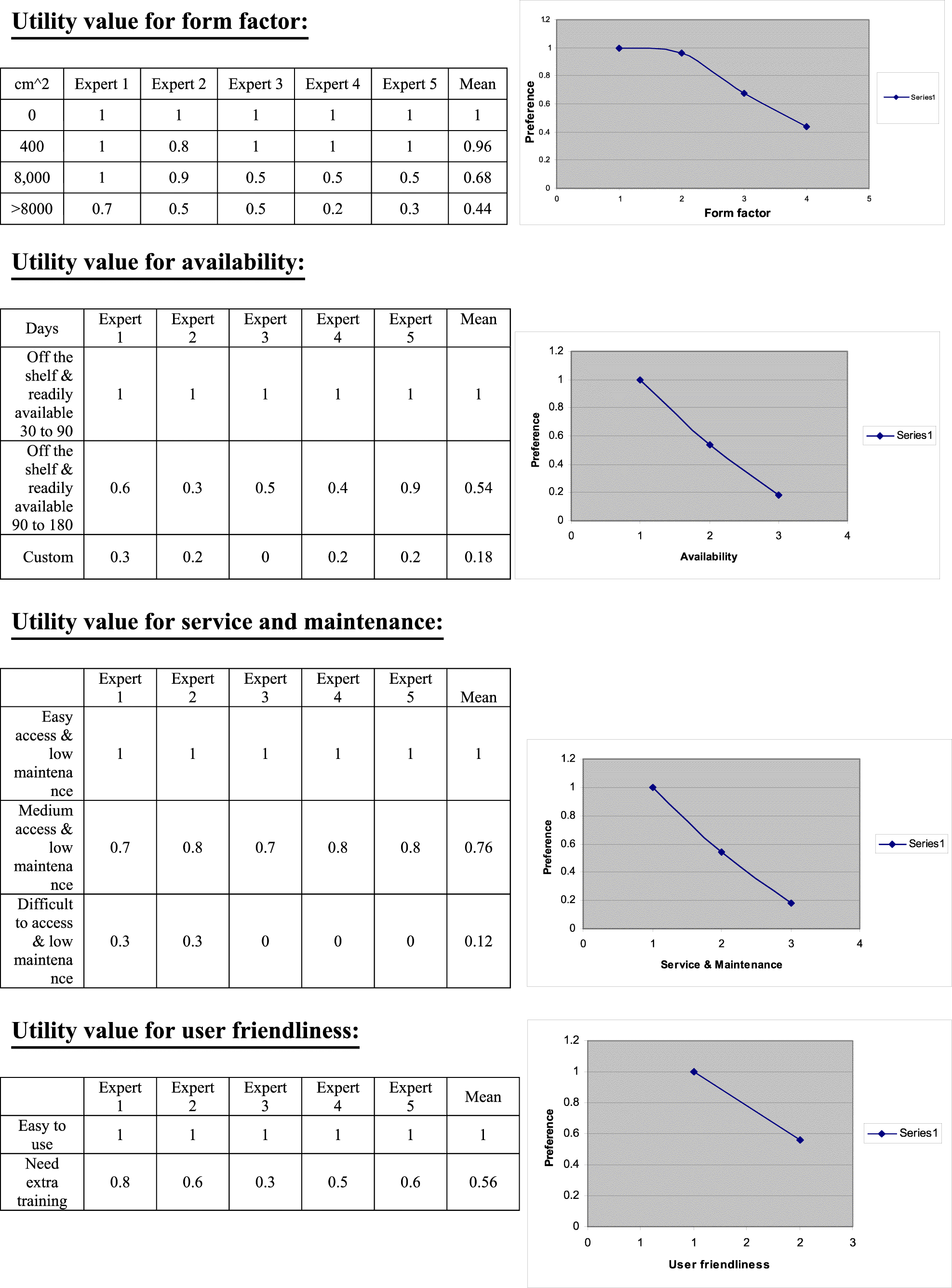

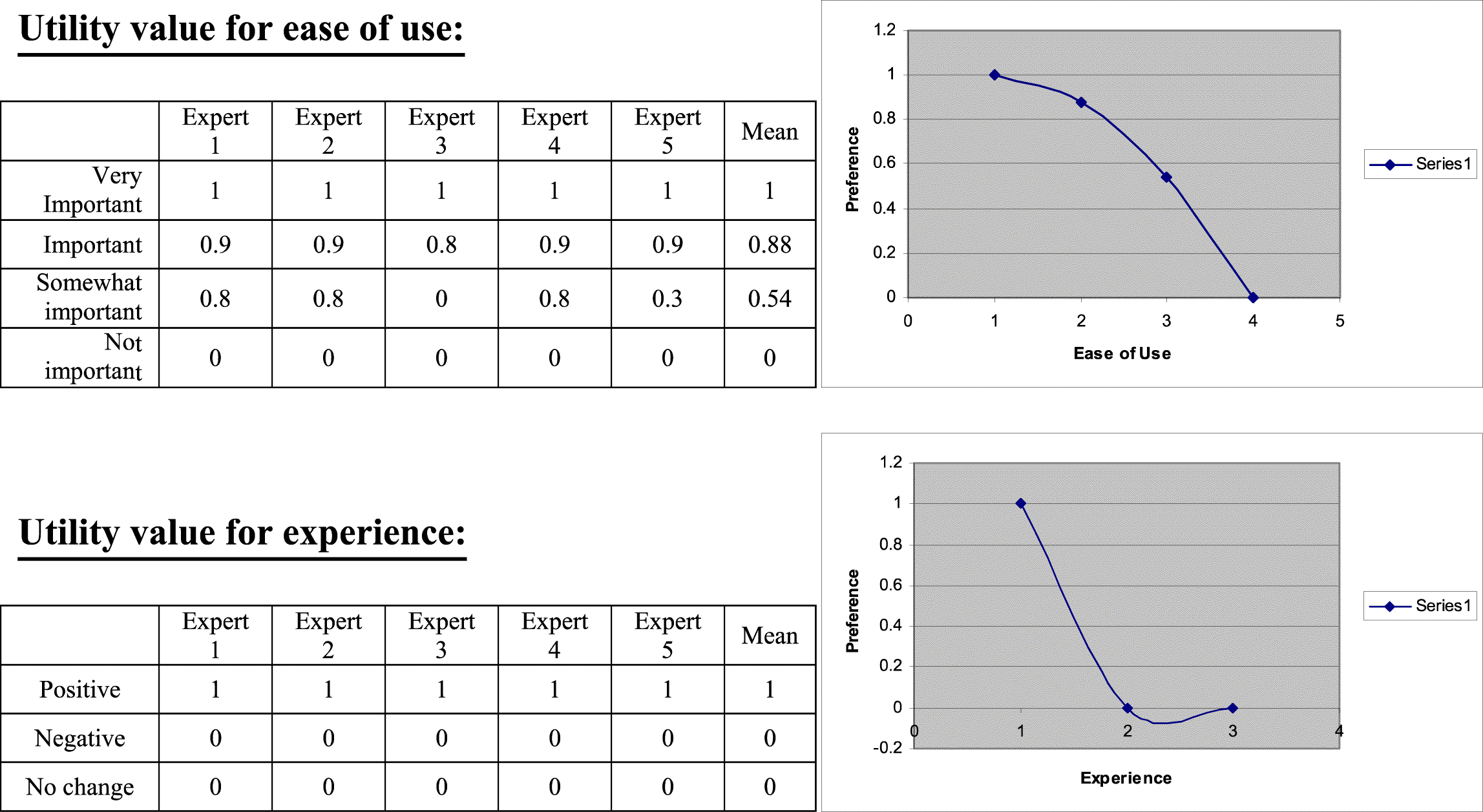
Appendix 2. Expert scores, pair-wise comparison calculations and expert bios
For each pair: total = 100
Distribute 100 points between the two elements with respect to each other.
For example, if one element is viewed to be four times as high as the other one, 80 and 20 points are allocated, respectively.
If one is considered slightly higher than the other, the allocation could be 52 and 48. If they are equal in value, each is given 50 points.
